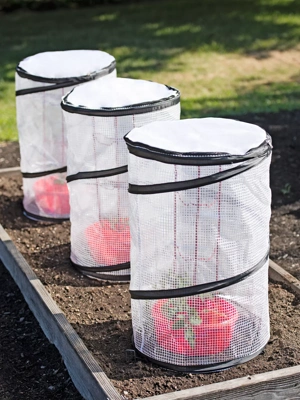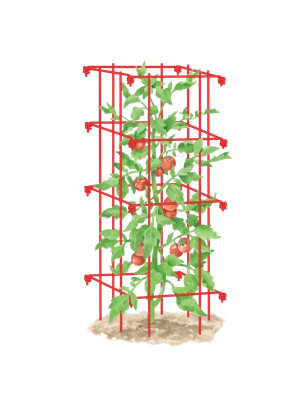Six Ways to Make Your Tomatoes Grow Faster
Get the first ripe tomatoes in your neighborhood!

How To Make Tomato Plants Grow Faster
Choose a Fast-Maturing Variety
Plant a quick grower, such as the 4th of July Tomato, and you'll be eating your first ripe tomato in as little as 49 days after transplanting. Compare this with varieties that take 80 or 90 days to reach maturity — you'd have to wait an extra month or more for ripe fruit. When selecting transplants or purchasing seeds to start indoors, check variety descriptions for the number of days to maturity.
Warm Up the Soil
Tomatoes grow best in warm soil; chilly soil will slow their growth. If your garden beds are covered with mulch, pull it back in early spring to expose the soil to the sun's warmth. Placing a sheet of clear plastic over the bed will also help. The soil in raised beds drains and warms up faster than in-ground garden soil — raised beds and containers are ideal for heat-loving tomatoes!
Harden Off Plants
Whether you grew your own tomato plants from seed or purchased them, they'll need hardening off to acclimate them to outdoor conditions. About a week before you plan to set the seedlings into the garden, place them in a protected spot outdoors (partly shaded, out of the wind) for a few hours, bringing them in at night. Gradually, over the course of a week or 10 days, expose them to more and more sunshine and wind. Our Pop-Up Tomato Accelerator lets you skip the hardening off process. Place one of these mini-greenhouses over each tomato seedling at planting time to protect it as it acclimates. Watch our Pop-Up Tomato Accelerator in action below!
Protect Young Tomato Plants from Wind and Chill
Temperatures in the 50s and cooler dramatically slow plant growth, and wind dries out plants and can cause fragile stems to break. Plant your tomatoes on the south side of the house to take advantage of the warmer microclimate.  Or, use our Pop-Up Tomato Accelerator to create a protected microclimate anywhere.
Or, use our Pop-Up Tomato Accelerator to create a protected microclimate anywhere.
Wait to Apply Mulch
Leave the soil bare around new transplants for the first month or so, to allow the sun to continue to warm the soil. Once summer weather arrives in earnest, you can apply a 2" layer of straw or shredded bark to help conserve soil moisture.
Support Plants
Flopping stems and sprawling foliage shade the maturing fruit, which delays ripening. Install sturdy cages, ladders or other supports at planting time to keep plants upright. Learn how to properly stake and support tomato plants in the video below!
Last updated: 09/14/2023
Print this Article:
Related items
Get the Dirt
Stay up to date on new articles and advice. Please fill out the information below.








